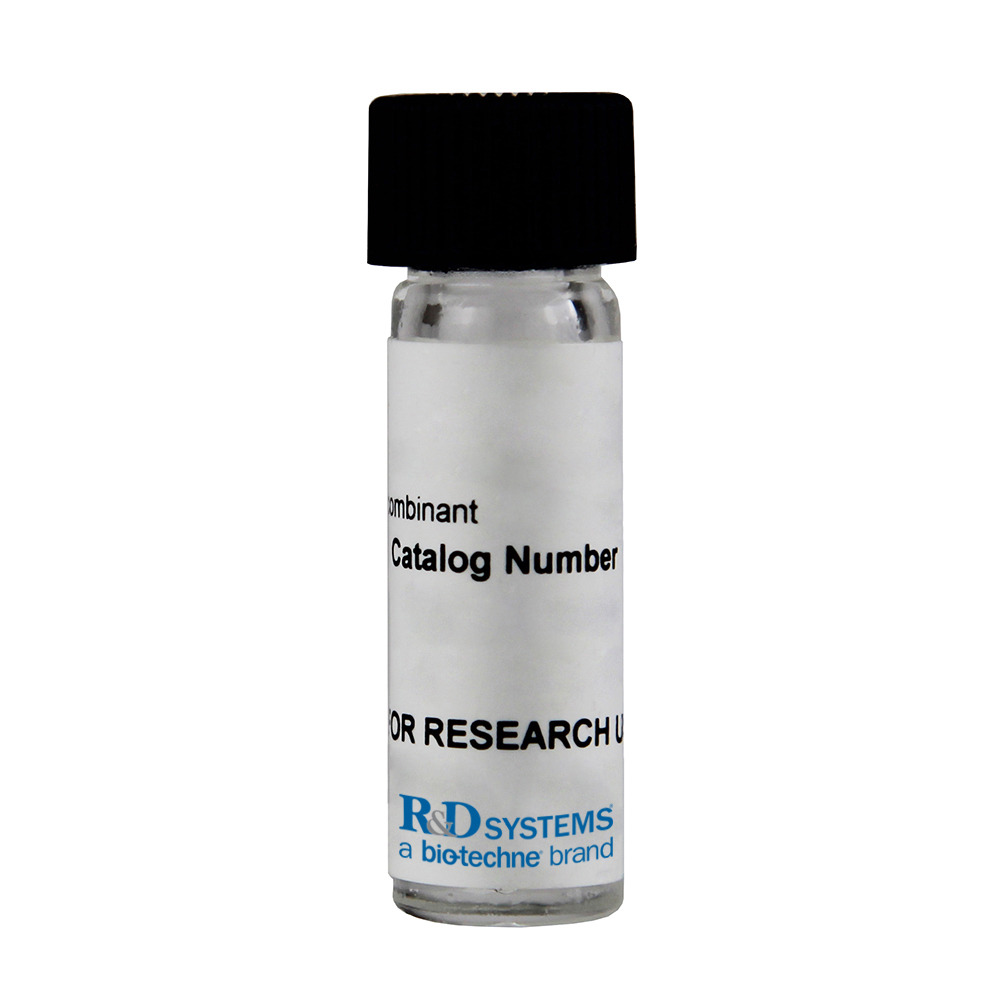 全部商品分类
全部商品分类

 下载产品说明书
下载产品说明书 下载SDS
下载SDS 用小程序,查商品更便捷
用小程序,查商品更便捷


 收藏
收藏
 对比
对比 咨询
咨询Carrier Free
CF stands for Carrier Free (CF). We typically add Bovine Serum Albumin (BSA) as a carrier protein to our recombinant proteins. Adding a carrier protein enhances protein stability, increases shelf-life, and allows the recombinant protein to be stored at a more dilute concentration. The carrier free version does not contain BSA.
In general, we advise purchasing the recombinant protein with BSA for use in cell or tissue culture, or as an ELISA standard. In contrast, the carrier free protein is recommended for applications, in which the presence of BSA could interfere.
338-AC
| Formulation | Lyophilized from a 0.2 μm filtered solution in Acetonitrile and TFA with BSA as a carrier protein. |
| Reconstitution | Reconstitute at 100-500 μg/mL in sterile 4 mM HCl. |
| Shipping | The product is shipped at ambient temperature. Upon receipt, store it immediately at the temperature recommended below. |
| Stability & Storage: | Use a manual defrost freezer and avoid repeated freeze-thaw cycles.
|
338-AC/CF
| Formulation | Lyophilized from a 0.2 μm filtered solution in Acetonitrile and TFA. |
| Reconstitution | Reconstitute at 100-500 µg/mL in sterile 4 mM HCl. |
| Shipping | The product is shipped at ambient temperature. Upon receipt, store it immediately at the temperature recommended below. |
| Stability & Storage: | Use a manual defrost freezer and avoid repeated freeze-thaw cycles.
|
Recombinant Human/Mouse/Rat Activin A Protein Summary
Product Specifications
Gly311-Ser426
Analysis
24 kDa, non-reducing conditions

Background: Activin A
Activin and Inhibin are members of the TGF-beta superfamily of cytokines and are involved in a wide range of biological processes including tissue morphogenesis and repair, fibrosis, inflammation, neural development, hematopoiesis, reproductive system function, and carcinogenesis (1‑7). Activin and Inhibin are produced as precursor proteins. Their amino terminal propeptides are proteolytically cleaved and facilitate formation of disulfide-linked dimers of the bioactive proteins (8, 9). Activins are nonglycosylated homodimers or heterodimers of various beta subunits ( beta A, beta B, beta C, and beta E in mammals), while Inhibins are heterodimers of a unique alpha subunit and one of the beta subunits. Activin A is a widely expressed homodimer of two beta A chains. The beta A subunit can also heterodimerize with a beta B or beta C subunit to form Activin AB and Activin AC, respectively (10). The 14 kDa mature human beta A chain shares 100% amino acid sequence identity with bovine, feline, mouse, porcine, and rat beta A.
- Kumanov, P. et al. (2005) Reprod. Biomed. Online 10:786.
- Maeshima, A. et al. (2008) Endocr. J. 55:1.
- Rodgarkia-Dara, C. et al. (2006) Mutat. Res. 613:123.
- Werner, S. and C. Alzheimer (2006) Cytokine Growth Factor Rev. 17:157.
- Xu, P. and A.K. Hall (2006) Dev. Biol. 299:303.
- Shav-Tal, Y. and D. Zipori (2002) Stem Cells 20:493.
- Chen, Y.G. et al. (2006) Exp. Biol. Med. 231:534.
- Gray, A.M. and A.J. Mason (1990) Science 247:1328.
- Mason, A.J. et al. (1996) Mol. Endocrinol. 10:1055.
- Thompson, T.B. et al. (2004) Mol. Cell. Endocrinol. 225:9.
- Harrison, C.A. et al. (2005) Trends Endocrinol. Metab. 16:73.
- Onichtchouk, D. et al. (1999) Nature 401:480.
- Gray, P.C. et al. (2002) Mol. Cell. Endocrinol. 188:254.
- Kelber, J.A. et al. (2008) J. Biol. Chem. 283:4490.
- Phillips, D.J. et al. (1997) J. Endocrinol. 155:65.
- Schneyer, A. et al. (2003) Endocrinology 144:1671.
- Ghorbani-Dalini, S. et al. (2020) 3 Biotech. 10:215.
- Mennen, R. H. et al. (2022) Reprod Toxicol. 107:44.
- Mishra, S. et al. (2021) Stem Cells. 39:551.
- Tanigawa, S. et al. (2019) Stem Cell Reports 13:322.
- Cangkrama, M. et al. (2020) Trends Mol. Med. 26:1107.
- Ries, A. et al. (2020) Expert Opin. Ther. Targets. 24:985.
- Pinjusic, K. et al. (2022) J. Immunother. Cancer. 10:e004533.
- Dadheech, N. et al. (2020) Stem Cell Res. Ther. 11:327.


参考图片
1 μg/lane of Recombinant Human/Mouse/Rat Activin A was resolved with SDS-PAGE under reducing (R) and non-reducing (NR) conditions and visualized by silver staining, showing single bands at 14 kDa and 24 kDa, respectively.
BG01V human embryonic stem cells were differentiated into endoderm using media supplemented with Recombinant Human/Mouse/Rat Activin A (Catalog # 338-AC). Control cells were cultured in medium without recombinant Activin A. Differentiation into endoderm was confirmed by positive-staining for Claudin-6 (red) and Sox17 (green) using the Mouse Anti-Human Claudin-6 Monoclonal Antibody (Catalog # MAB3656) and the Goat Anti-Human Sox17 Polyclonal Antibody (Catalog # AF1924), respectively. BG01V human embryonic stem cells are licensed from ViaCyte, Inc.
Recombinant Human/Mouse/Rat Activin A (Catalog # 338-AC) induces hemoglobin expression in K562 human chronic myelogenous leukemia cells. The ED50 is typically 0.2‑1.2 ng/mL.





